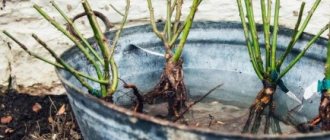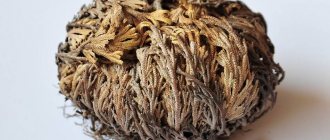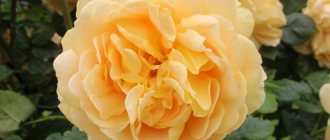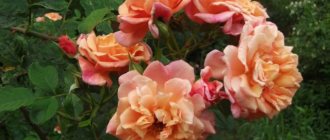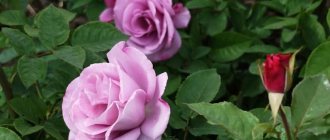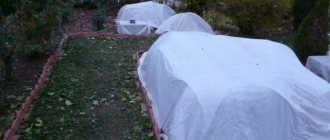Description of the variety Mimi Eden
The rose variety Mimi Eden has average resistance to fungal diseases; it gets sick during the spread of infection and with improper care. The flowering of the bush worsens in rainy weather.
The frost resistance of the variety is average, withstands temperatures down to -26 degrees. The period of active flowering of the crop lasts from mid-June to mid-September, during which time the plant produces 2-3 waves with breaks of 2 weeks.
| Color | Deep pink, white edges |
| Number of flowers per stem | From 5 to 10 |
| Aroma | Weak |
| Flower size | 3-4 cm |
| Bush height | 55-85 cm |
| Bush width | 90-110 cm |
| Frost resistance | Frost-resistant, zone 6 |
| Powdery mildew resistance | Average, gets sick in unfavorable years |
| Black spot resistance | Average, gets sick in unfavorable years |
| Rain resistance | Average, in rainy weather not all buds open |
| Bloom | Reblooming |
| Bush shape | Semi-spreading |
| Flower | Dense double |
Rose Mini Eden (Mimi Eden) - what kind of variety is it, history of creation
This variety of miniature roses was bred by French botanists from Meilland in 2001. Its aroma is a combination of notes of hibiscus and red grapes. Having won the attention of experienced flower growers and amateurs, the Mimi Eden rose has taken a strong position and has become an integral part of most garden plots.
This variety belongs to the floribunda group, obtained at the beginning of the 20th century as a result of long and repeated crossings of tea roses with polyantha. Translated, the name of the variety means (abundant flowering), which fully characterizes it.
Rose Mimi Eden
Ground cover rose Mini Eden: brief description, characteristics
This variety belongs to the subspecies of spray flowers. The bushes grow small - only 40-70 cm in height. There are practically no thorns on the stems, and it also bears glossy bright green leaves. From mid-summer until the first autumn frosts, a small bush pleases its owner with abundant flowering. About 5-10 buds grow on the peduncle, which gradually open, replacing each other. The inflorescences are two-colored, spherical in shape. The dense, soft pink core gives way to a white-green edging. The diameter of the flower rarely exceeds 5 cm.
Advantages and disadvantages of the variety
On the Internet you can find a description of the rose Mimi Eden as an unpretentious resident of a garden or park. Plants of this variety tolerate rainy and cool weather well. Moreover, the rays of the sun are more destructive for them than frost. Inflorescences may lose their bright colors.
The flowers bloom and stay on the stem for about 20 days. After complete flowering, they disappear on their own. This is a big plus for flowering plants, as nutrients are distributed evenly throughout the season.
If all the rules were followed during planting, this practically guarantees resistance to diseases and pests.
Use in landscape design
This is an incredibly beautiful and sophisticated bush plant. Groundcover rose Mimi Eden is often used to decorate garden plots and border areas. To place them along paths, many gardeners prefer to grow them in containers or flower beds. Abundant flowering and small size of flowers also attract florists. Roses can be used to create floral arrangements in bouquets.
Decoration of the pedestrian zone
Appearance and features
Rose Mimi Eden is painted in two colors. Depending on the light and the condition of the plant, the shades become brighter or fade. Ideally, a Mimi Eden rose should have a bright pink center and light ivory outer petals.
Some specimens have a less noticeable transition of shades - the bright center is framed by pale pink petals. The bud is in the shape of a deep round bowl, the petals are densely packed; one rose can have from 27 to 40 petals. Roses grow in spherical inflorescences. The edges of the petals are wavy. The aroma of roses is weak, light floral notes are felt.
The Mimi Eden variety shrub is not tall, does not grow higher than 85 cm, most often its height is about 50 cm. The miniature bush grows quite widely, its stems are dense, covered with glossy foliage of a rich green color. There are very few thorns on the shoots.
Content Rules
Schisandra is a rather attractive and at the same time not very difficult to care for plant that can grow in an aquarium at your home. This type of plant is intended for growing in large aquariums (from 150 liters). In order for your plant to maintain its original attractive appearance, it is necessary to properly care for it. Everyone knows that aquarium lemongrass is prone to very rapid growth, and if you do not want it to take up most of your aquarium, you need to monitor its size and trim the stem in time and shorten the shoots.
Popular articles Description of the Majestic Blue prickly spruce, its planting and care
And there are also a number of conditions that will help your “green pet” feel comfortable in its habitat.
The soil. It is imperative to have a clay-peat layer at least 5 centimeters wide. Schisandra will feel comfortable in a muddy substrate with fertilizers that include phosphorus, calcium, and magnesium.
Photo
_rosesmol_
nadyschka_garden
nadyschka_garden
countryflowers
_myflowersdream_
Diseases
Does the rose have a gray-white coating or brown balls on the leaves? Methods to combat the disease.
Powdery mildew
Black spots of a round shape have appeared on the leaves of the rose, what should I do, how can I save the plant?
Black spot
The rose is sprinkled with yellow powder, the leaves and stems crack and die, how to get rid of the disease?
Rust
Has a gray coating appeared on the rose? This is gray rot that needs to be gotten rid of as soon as possible.
Gray rot
The plant should be planted in spring from mid-April to late May or early autumn. It is recommended to start from the average daily air temperature, which should be between 18-20 degrees.
The bush should be planted in a shaded place; the scorching sun burns the delicate petals, discolors the rose and impairs the quality of flowering. For the Mimi Eden variety, moist, light soil with an acid reaction of 5.6-7.3 pH is suitable.
The roots of the seedling need to be treated before planting, soak them in clean water or in a solution of a growth stimulator, remove weak shoots and shorten excessively long shoots. Seedlings need to be planted in holes 50 cm deep, the width depends on the volume of the root system.
At the bottom of the hole it is necessary to lay drainage made of expanded clay or gravel and a soil mixture of manure, fertile soil, sand and peat in a ratio of 3:2:2:1. At the end, you need to water the planting abundantly.
It is necessary to water the bush carefully; waterlogging or drying out of the soil is unacceptable. Stagnation of water provokes rotting of the root system. Watering is carried out once a week; one bush requires 8 liters of warm, settled water.
To stimulate growth and flowering, it is necessary to carry out proper feeding. In the spring, nitrogen fertilizer should be applied to the bush; in the summer, a mineral complex of phosphorus and potassium should be applied. The last fertilization should be carried out in September, this strengthens the plant before wintering.
Pruning of the plant should be done in the spring before the buds awaken. The bush must be rejuvenated by removing old stems and getting rid of dry and weak shoots. The rose variety Mimi Eden is recommended to be covered for the winter.
Spunbond, burlap or spruce branches can be used as covering material. The top of the bush needs to be covered with peat. There should be a small distance between the perennial and the ground; the shoots should not lie on the ground, otherwise they will begin to rot.
Flower propagation
Garden varieties of roses are the result of long and hard work of many breeders. A completely unexpected result can come from a seed. Therefore, Mimi Eden is propagated by cuttings.
Cuttings
When is it produced?
Reproduction is best done in the active phase of flower growth. The most favorable time is June and the first half of July. Over the remaining season, the root system will grow and become stronger, which will allow the flower to survive the first winter.
Detailed description
To do this, the middle of the flower stem, about 15-20 cm long, is cut off. One end is treated with wax to prevent infection, and the other is treated with a root formation stimulator. After completing the procedure, the cutting is placed in the ground. The top of the cutting is covered with film or a plastic bottle.
Pests
Microscopic spiders have appeared on the plant, and the rose is gradually becoming covered with cobwebs, what should I do?
Spider mite
Are small green insects destroying your rose? Effective methods of pest control.
Green rose aphid
Caterpillars have appeared on the rose and are twisting the leaves of the plant, how to deal with the pest
Rose leaf roller
Flat bumps have appeared on the shoots of the rose or on the underside of the foliage, how to deal with the pest
Rosen scale insect
Roses often become victims of insect pests, especially spider mites, aphids, and leaf rollers. For spider mites, it is recommended to use Actellik solution or soap solution. An infusion of wormwood helps against aphids; large colonies must be combated with insecticides. Leaf rollers are eliminated by spraying with insecticides.
Further care of the crop and preparation for winter
Despite the fact that the Canadian rose is very unpretentious, for the crop to bloom several times a year, it is necessary to surround it with care and attention. You need to prune the plant with the onset of spring, and remove those shoots that are dry, frozen or damaged.
Important! If you prune the Explorer rose in the autumn season, it may become “confused” in the seasons and enter a phase of active growth in the absence of persistent frosts in November. In order for rose bushes to bloom profusely, they need to be fed with mineral complexes, which include nitrogen, potassium and phosphorus
Despite the fact that the plant is quite drought-resistant, it needs to be watered if the weather is very hot and dry in the summer, and it also needs to be watered abundantly during feeding.
In order for rose bushes to bloom profusely, they need to be fed with mineral complexes, which include nitrogen, potassium and phosphorus. Despite the fact that the plant is quite drought-resistant, it needs to be watered if the weather is very hot and dry in the summer, as well as abundant watering during the feeding process.
Special attention should be paid to preparing rose bushes for winter to avoid possible losses. The base of the plant must be mulched using loose compost soil (no more than 3 buckets)
Then you need to bend the branches to the soil and “pin” them using wood slingshots. If severe frosts suddenly occur, you must immediately remove all the buds that did not have time to bloom, and then cover the bushes with covering material.
Feeding roses
Periodically throughout the winter, it is recommended to cover rose bushes with snow, as this helps to improve the wintering of the plant. In the spring, it is strictly forbidden to delay opening the bushes, because melt water and high air temperatures can lead to the plant being supported. It is best to open Explorer roses in the second half of March.
Options for using rose Mimi Eden
Rose Mimi Eden is a miniature, lush-flowering bush that is suitable for growing in open ground or in a container. The bush can be planted in colorful group flower beds among crops in red, yellow, blue, white, and pink shades.
The plant is suitable for mixborders. Roses are used in border plantings and for zoning areas. Roses can be planted alone in the middle of the plot or in separate rose gardens.
Useful tips
- Rose variety Mimi Eden can be affected by powdery mildew and black spot. If white plaque or black spots appear on the leaves, it is recommended to treat with fungicides;
- To prevent the appearance of fungal diseases when pruning, you need to disinfect the pruning shears, do not plant the plants too often and treat them with various infusions;
- Weeding the area occupies an important place in rose care. Weeds must be removed regularly to protect the bush from fungus, insects and depletion.
Plant care
In order for the Purple Eden rose to delight with lush flowering, you need to provide the bushes with suitable care.
Watering rules
For normal growth, bushes need regular but moderate watering. Each plant requires 20 liters of settled water; irrigation is carried out in the morning or evening; doing this during the day is strictly prohibited. To reduce moisture evaporation, the tree trunk circle is covered with organic mulch.
Fertilizing and soil quality
The plant responds gratefully to spring fertilizing with organic matter (diluted manure or droppings, otherwise the roots can be burned). At the budding stage, fertilizing with a potassium-phosphorus complex will be useful.
The soil needs to be breathable and light. To maintain the concentration of useful substances in it, weeds are regularly removed.
Bush pruning
Rejuvenating pruning at Ebb Tide is carried out in the spring, 4-5 of the strongest shoots are preserved, all old and diseased branches are cut off. In the fall, repeated pruning is carried out, the purpose of which is to prepare for wintering.
Features of wintering a flower
In order for the Ebb Tide rose to survive winter frosts, it is important to properly prepare it. First of all, the bushes are pruned, then hilled, the height of the soil layer is 20-30 cm
Next, the plantings are covered with spruce branches; you can also use film or agrofibre stretched over the frame. After snow falls, it is thrown over the bushes for additional protection.
Note! Covering material is removed in March or April, when there is no threat of frost.
Beautiful flowers will delight the gardener's eye only if they take care of them responsibly
Pros and cons of the Mimi Eden variety
Advantages:
- Lush flowering in tassels;
- Unusual two-tone color;
- Miniature, compact bush;
- A small number of thorns on the shoots;
- Good frost resistance;
- Light, pleasant aroma.
Flaws:
- Susceptible to infection by fungal diseases and attacks by insect pests;
- In the rain, the flowering of the bush decreases.




